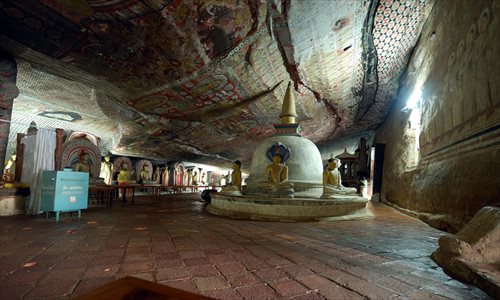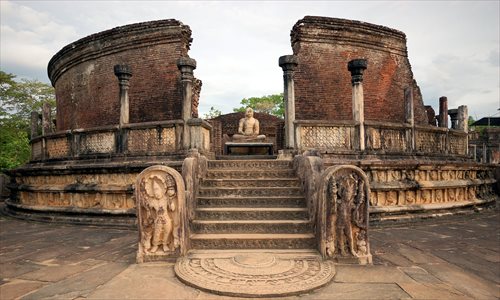HOME >> LIFE
In Sri Lanka, looking for serendipity
By Angela Corrias Source:Global Times Published: 2013-9-21 5:03:01

Elephant Orphanage Photo: Angela Corrias

Rock Temple in Dambulla Photo: Angela Corrias
When you travel to a small country, you might think of it as limited in tourist attractions and activities.This is often true, but not when it comes to Sri Lanka. With 65,000 square kilometers, former Ceylon sets aside some pretty winsome experiences for its lucky visitors.
In two weeks, my senses were so intensely involved that even now when I'm back at my desk I only need to close my eyes and sip my black tea from Lover's Leap to bring back memories from my trip to paradise in the middle of the Indian Ocean.
From the very moment I landed at Colombo International Airport, it was clear to me why Arab traders had named it Serendib, or "pleasant surprise."
A vast sweep of lush greenery was unfolding before my eyes making me realize that it really was the right place for reaching serendipity.

A statue of Buddha welcomes visitors at Sri Lanka's ancient site of Polonnaruwa. Photo: Angela Corrias
Colorful ColomboMy first day in the country's capital, Colombo, was one of adjustment, plunging into Sri Lankan life, exploring its customs and slowly getting under the skin of the place. My travel companions and I decided to kick off our journey from the Handicrafts Village in Battaramulla Jana Kala Kendraya premises for a first grasp of local art and craft. Handmade lace, eerie wooden masks to ward off evil, batik sarongs and traditional drums were only some of the goods being crafted during our visit, and the bamboo trees and colorful fabrics hanging from the huts completed a perfect exotic landscape.
Since Buddhism is the dominant religion in Sri Lanka, we deemed it only natural to carry our tour on at Gangaramaya Temple, a confusing yet welcoming mix of Buddhist and Hindu icons. Colorful and littered with a diverse range of sacred symbols, everything in the temple seems to shout, even though it somehow manages to relax your senses, inevitably put through the wringer by Colombo's chaotic reality.
Luckily enough, we arrived just in time for a ceremony and joined a small gathering, listening in on the mesmerizing chants of an orange-clad monk who conveyed a sense of harmony.
Much to my pleasure, the temple/shrine of Seema Malaka was very close, almost the spontaneous continuation gently nestled on an island on Beira Lake. If Gangaramaya struck me for its eclectic and loud attitude, Seema Malaka was the perfect place to end a long but rewarding day. Sitting on the edge of a stone building and surrounded by lavish vegetation, small temples enshrining the main Hindu gods, and a few monks enjoying the evening breeze and the lights flitting on the calm waters, the hour spent there felt almost as if we were out of Colombo witnessing from afar its never-ending traffic and the persistent honking of its cars and rickshaws.
Sri Lanka's capital, sprawled along the country's western coastline, boasts a great two-storey National Museum and a Natural History Museum all in the same complex along with the fancy Barista cafe and the unmissable Laksala, government-owned craft and souvenir shop. Those who want to immerse in nature can have lunch at the beautiful public park right in front of the back gate of the museum complex, Viharamahadevi Park which, apart from many species of tropical plants, also hosts a small aquarium. Several kaleidoscopic Hindu temples and a series of posh restaurants complete a wide range of tourist attractions. But, if you are bent on unearthing the nitty-gritty of Colombo, hop on one of the many three-wheeled tuk-tuks and head to Pettah, possibly the city's most colorful, lively and smelly neighborhood, where you can find everything from yellow coconuts and spices to beautiful sarees and men's sarongs.
Even though Colombo has enough to keep you busy for days, we were determined to explore more of the country. Starting with the quaint city of Galle, 120 kilometers south from the capital, we felt as if whirled back in colonial times, when Dutch occupied the area. Although founded by the Portuguese, who built it mixing European architectural style with South Asian patterns, Galle was conquered by the Dutch in 1640, and gave the town the unmistakable touch of a heavily fortified city, the only decoration of which were Protestant churches, which are still operative today.
Southern Sri Lanka is famous for the beloved activity of whale watching, best experienced from the town of Mirissa during the giant mammals' mating season, from November to April. As we were well off-season, we decided to embark on a safari instead and headed to Tissamaharama town for a tour in Yala natural reserve.
Yala National Park is Sri Lanka's second largest park and a must-see attraction. The highlight of the safari, and predictably the rarest sighting, involved spotting one of the gorgeous 25 leopards living there. We were all still languishing in a state of torpor when our guide woke us up, excitedly shouting, "Leopards!" Having had the chance to spot the precious felines, we felt extremely fortunate.

Sigiriya Photo: Angela Corrias
Tsunami victims rememberedSome two hours later we were brought to the beach enclosed within the park's borders, a pristine stretch of forest-edged sand lapped by crashing ocean waves.
On the beach, a memorial sadly common to much of the country's coastline commemorated the victims of the deadly tsunami in 2004 that took the lives of thousands of people in Sri Lanka. After nine years, the tragedy of the tsunami is far from forgotten. Although Sri Lanka was not hit as badly as Indonesia, the huge number of casualties and the trauma that followed are still very much present in people's mind. The killer waves caused by the undersea earthquake hit Yala Park at a speed of 800 kilometers per hour and covered a kilometer from the coast, causing the death of the 50 people visiting the park at that moment. Somehow in awe of their strong connection with nature, our guide told us that no animal had been killed nor carried away as they felt the earth shaking in time to run inland, far away from the coast.
Before 10 am we resumed our journey around Sri Lanka, this time heading north, but not without a stop in Nuwara Eliya, a picturesque valley town blessed with breathtaking mountainous views and home to the legendary Ceylon tea. The road was filled with bends and near-misses, and before reaching the beautiful town set on the shores of Gregory Lake, we stopped at Elephant Orphanage in Pinnawala in time to witness the daily ritual of a gigantic herd returning home from the river and the feeding of baby elephants.
As a great tea lover, I couldn't conceive a stay in Nuwara Eliya without visiting at least one of the tea factories. At Pedro Estate we found out how the leaves of my beloved drink is plucked and processed. All of this was after reaching the country's highest peak on Pidurutalagala mountain, thoroughly enjoying the area's charming boulevard, lined with tropical trees.
For the hard-core climber
We decided to climb the famous Adam's Peak. A pilgrimage site and one of the country's holiest mountains, Adam's Peak is said to be the first place where Adam set foot on Earth after being banned from heaven and the last place that Buddha stepped on before reaching Nirvana. During pilgrimage season some 20,000 faithful Buddhists climb to the top to visit and worship the sacred image of Buddha's footprint.
Despite being warned against the climb due to the off-season, freezing temperatures and difficulty of the climb, we stubbornly persisted, ill-equipped for 5,500 slippery, shaky and irregular steps in a pitch-black route. Dazed by altitude and fatigue, some four hours later we stepped on the peak only to find out that all the warnings we were given were materializing one by one, with the final surprise that the thick fog was preventing us from witnessing the famous sunrise.
Exhaustion and body aches all over didn't allow us to fully appreciate the adventure we had just embarked on, and probably still now that it's becoming a far memory studded with funny moments we are mulling over the possibility that the whole endeavor was not worth it.
We continued further north to visit what was for me the highlight of the trip, the ancient sites of Sigiriya and Polonnaruwa. Finding out that our first stop, Sigiriya, involved climbing another 1,400 steps did bring back some painful reminiscence in our muscles but didn't put us off, and this time the reward definitely paid off.
We made our way back to the capital, stopping off along the way at the famous Rock Temple in Dambulla, an intriguing worship place carved out of five caves some 180 meters above the road, where Buddha images and beautiful paintings contribute in making the temple a fascinating and unusual experience starting with a massive 14-meter statue of a sleeping Buddha said to be in the Parinirvana status, his final passing away.
Completely tired out, we made time for an Ayurvedic treatment back in the capital. Many hotels in Colombo provide spa facilities, but what I was looking for was the proper local way to relax and benefit from traditional herbal ingredients and Ayurvedic knowledge. I found this in Siddhalepa, an Ayurveda Spa that after an hour managed to relieve the aching of the last three days spent climbing and mentally prepared me for the end of holidaying and a return to my daily work routine.
Posted in: Adventures